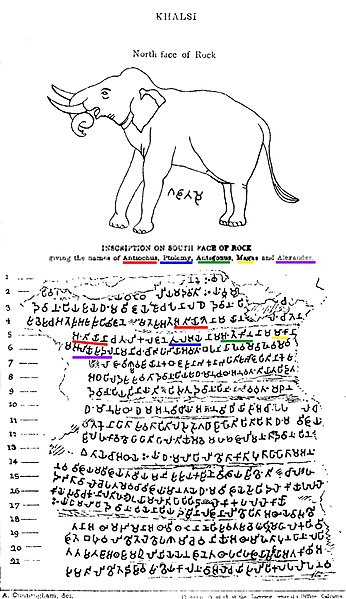The history of Buddhism can be traced back to the 5th century BCE. Buddhism arose in Ancient India, in and around the ancient Kingdom of Magadha, and is based on the teachings of the renunciate Siddhārtha Gautama. The religion evolved as it spread from the northeastern region of the Indian subcontinent throughout Central, East, and Southeast Asia. At one time or another, it influenced most of Asia.
The image, in the chapter on India in Hutchison's Story of the Nations, depicting Ajātasattu visiting the Buddha to assuage his guilt.
The words "Bu-dhe" (𑀩𑀼𑀥𑁂, the Buddha) and "Sa-kya-mu-nī" ( 𑀲𑀓𑁆𑀬𑀫𑀼𑀦𑀻, "Sage of the Shakyas") in Brahmi script, on Ashoka's Lumbini pillar inscription (circa 250 BCE).
Fragment of the 6th Pillar Edict of Aśoka (238 BCE), in Brāhmī, sandstone. British Museum.
Mallakas defending the city of Kusinagara, as depicted at Sanchi. The leader of the Mallakas, under siege, by the seven gods, during the War of the Relics, which were objects associated with the Buddha. The Mallakas were an ancient Indian republic (gaṇasaṅgha) that constituted one of the solasa (sixteen) Mahajanapadas (great realms) of ancient India as mentioned in the Anguttara Nikaya.
The word Yona in Pali and the Prakrits, and the analogue Yavana in Sanskrit and Yavanar in Tamil, were words used in Ancient India to designate Greek speakers. "Yona" and "Yavana" are transliterations of the Greek word for "Ionians", who were probably the first Greeks to be known in India.
Territories "conquered by the Dharma" according to Major Rock Edict No.13 of Ashoka (260–218 BCE).
The Khalsi rock edict of Ashoka, which mentions the Greek kings Antiochus, Ptolemy, Antigonus, Magas and Alexander by name (underlined in colour). Here the Greek rulers are described as "Yona" (Brahmi: 𑀬𑁄𑀦, third and fourth letters after the first occurrence of Antigonus in red).
Dedication by a man of Greek descent on a wall of Cave 17 in the Nasik Caves (photograph and rubbing). Detail of the "Yo-ṇa-ka-sa" word (adjectival form of "Yoṇaka", Brahmi: 𑀬𑁄𑀡𑀓𑀲), with Nasik/Karla-period Brahmi script for reference. Circa 120 CE.
Foreigners on the Northern Gateway of Stupa I.








